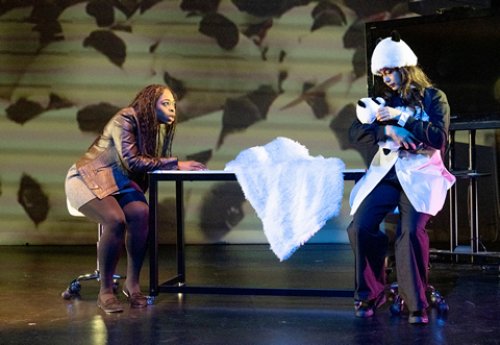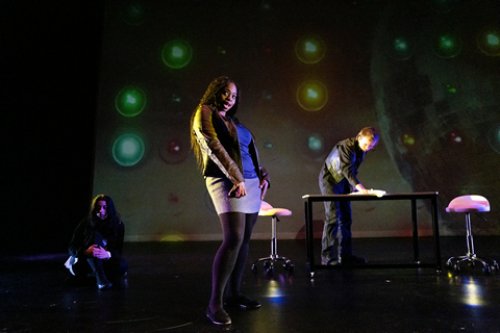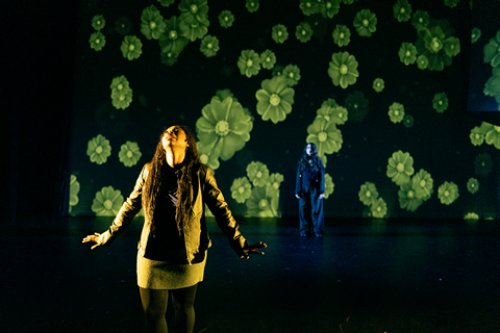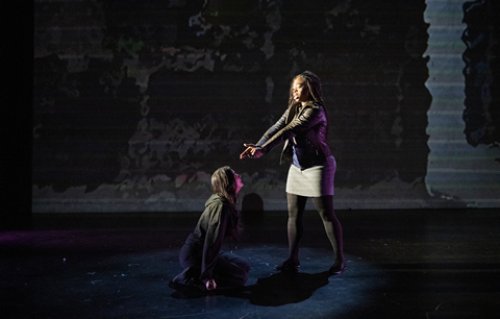January
A play about the emotional impact on the mothers of the killing of one child by another.

Alinca Hamilton as Lauren and Darlenis Duran as Maya in a scene from Paula Cizmar’s “January” at The Theatre at the 14th St Y (Photo credit: John Quilty)
One of the most devastating things that can happen to a parent is the death of their child. It is a more profound event when the child is killed by another child. In such a tragic circumstance, the parents usually endure the consequences. Sometimes, there is only one parent without the emotional support of a partner, and the effects of the tragedy are compounded. The impact on two, one-parent families is the premise of the play January, written by Paula Cizmar and directed by Lorca Peress.
January presents a story about the emotional impact of the killing of one child by another by weaving together the thoughts and actions of the two single mothers involved and how the national media treats the event. There are scenes blending memories and dreams with reality, presenting the protagonists’ thoughts as if they existed in real-life moments with an almost hallucinogenic quality. These dramatic devices work most of the time. Still, there is a critical point in the play where what is being presented goes on for too long, almost to the point of losing the story thread. The projections used are effective but sometimes come very close to being propagandistic. Even with some of the unevenness of the production, it does present an important story that needs to be told. January is a heavy lift emotionally but ultimately worth the effort.
The two mothers are played by Alinca Hamilton as Lauren and Darlenis Duran as Maya. The story is built around Lauren, a single mother of the boy who was killed. Hamilton gives a compelling performance of a mother juggling the rawness of grief with the intensity of the media spotlight being shined on her. The media hold up Lauren as an example of a heroic mother dealing with the death of her child and supposedly without feelings of recrimination towards the mother of the killer or of the killer himself. Those thoughts and feelings towards recrimination are at the heart of the story.

Alinca Hamilton as Lauren, Darlenis Duran as Maya and Matt Walting as the Bartender in a scene from Paula Cizmar’s “January” at The Theatre at the 14th St Y (Photo credit: John Quilty)
On the other hand, Maya is being cast as a villain who is somehow responsible for what her son did. The reality is that the police are holding her son, and her daughter has been placed with a foster family. The authorities are casting her as an unfit mother. In a sense, she is in the process of losing both of her children and from an emotional standpoint, the impact is almost as devastating as the death of a child. Maya’s thoughts, feelings, and actions operate in a loose contrast to Lauren’s thoughts and actions.
Three other members of the cast play multiple roles. Jed Peterson is Maya’s attorney, Henry, and a media person. Veronica Cruz plays a TV reporter and Maya’s mother, Joyce. Matt Walting embodies the media camera operator and bartender at a nightclub. They all effectively embody their characters as they move between.
Cizmar shows how the media manipulates the encounters with Lauren and Maya to suit what they think their audience wants to hear: Lauren, the hero, and Maya, the villain. By exploiting both mothers, the media is seeking a clear entertainment value but with a propagandistic extension.

Alinca Hamilton as Lauren and Darlenis Duran as Maya in a scene from Paula Cizmar’s “January” at The Theatre at the 14th St Y (Photo credit: John Quilty)
MEDIA PRESENCE FEMALE (Cruz)
That’s right. So remember, there’s a lot of people who think they can just solve all this by starting to ban things and get rid of the Bill of Rights and just want to blame objects ‘cause they don’t want to take the blame themselves—
LAUREN Oh. Uh.
MEDIA PRESENCE FEMALE
But you can talk about how really we just all need to be about teaching good Christian values—
And for Maya at her workplace.
MEDIA PRESENCE
Maya! Over here! Just a few questions—
MEDIA PRESENCE FEMALE
Maya! One comment on your son’s behavior the day of the killing—
MEDIA PRESENCE
Where were you on the—
The media scenes operate as a vehicle for Lauren to move off into a thought space where she processes ideas flowing from the killing of her son Jesse. She imagines conversations with Maya, the mother of the killer. These moments of reflection define Lauren as they reveal who she is, the life she has led, and where she sees her life going. The thoughts guide her to a resolution about the event and the people involved.

Alinca Hamilton as Lauren and Darlenis Duran as Maya in a scene from Paula Cizmar’s “January” at The Theatre at the 14th St Y (Photo credit: John Quilty)
Maya’s story is presented more directly in the workplace but mainly in the kitchen of her house. Her interactions with her mother, Joyce (Cruz), and attorney Henry (Peterson) not only provide background on her life but also define the growing desperation she feels with the possible loss of both of her children, one to jail and the other to a foster family. In one scene, during a conversation between Henry and Maya, Lauren leaves the TV studio and sits in the kitchen listening to the conversation.
The show is built with moments that border on hallucination: a scene where Maya and Lauren are on a foggy beach; moments when Lauren sits in on Maya’s conversations with her mother or lawyer. All lead up to a scene in a nightclub where Lauren begins a long soliloquy revealing important details about her life before, during, and after her son was born. Maya operates as a Greek chorus in an attempt to contrast the two women’s stories. It operates as a dream sequence but goes on for too long.
The show ends with a coda by Lauren, pulling together all of the thoughts and feelings she explored after the death of her son Jesse in an attempt to put a finality to all that had happened. It is a fitting ending to the play.
Jan Hartley’s projection design adds immeasurably to the action of the show with the possible exception of the anti-firearms messaging at one point in the play. The sound design by Un Hee Kil is effective in supporting the action both with the audio effects and with the microphone usage by the actors. Kia Rogers’ lighting design is essential in defining the different scene locations on what was a single large performance space. The costume design by Lisa Renee Jordan works well in defining the various characters especially in the case of actors playing multiple roles. The minimalist scenic design by Jennifer Varbalow is in keeping with the overall tone of the story.
January (through February 1, 2025)
The Femme Collective
The Theatre at the 14th St. Y, 344 East 14th Street, in Manhattan.
For tickets, visit https://ci.ovationtix.com/36649/production/1223385
Running time: 90 minutes without an intermission






Leave a comment